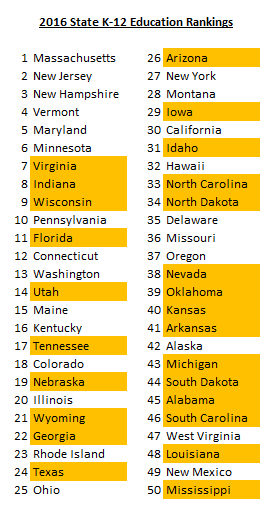As the Republican National Convention lurches on, teachers are once again under attack as one of the Republican party’s favorite whipping boys. In his speech Tuesday night, Donald Trump Jr. claimed that schools are currently set up to serve teachers and administrators, not students. He went on to say that Democrats “are more concerned about protecting the jobs of tenured teachers than serving the students in desperate need of a good education.”
This is a familiar talking point: the problem with education is that it is too hard to get rid of bad teachers, and so Johnny doesn’t learn because he has some lazy slob at the front of the room who won’t teach him. Why is it so hard to get rid of bad teachers? Well, teachers’ unions, naturally.
Except there’s an obvious hole in that logic.
The following is basically back-of-napkin calculation. It’s not intended to be a comprehensive study, just something I threw together in a few minutes of internet research.
In the table below are the 50 states ranked in order from best K-12 ranking to worst. I got the rankings from Quality Counts’s 2016 rankings, as reported in EdWeek. Don’t like that source? Feel free to substitute your own—from an organization without an obvious axe to grind, ideally—and see if the results are very different. This list is reasonably consistent with what I’ve always heard about which states provide the best and worst education in the country.

As you can see, I highlighted some of the states—specifically, the states listed in orange are “Right-to-Work” states. These are the 26 states that have passed laws weakening unions. If the Republican talking point is correct, if unions are the biggest problem with education today, you’d expect the states with strong unions to be at the bottom of the list, and the states with Right-to-Work laws to be at the top.
That correlation is pretty plainly not there. In fact, if anything there is a slight indication that the opposite correlation is there. Nine of the top thirteen states are not Right-to-Work states, while ten of the bottom thirteen states are.
Now, I’m not suggesting that this is evidence that strong teacher unions make schools better. Many of the higher-ranked states are also wealthier states. There are likely to be other confounding factors as well. But I am saying that at a quick glance, the claim that teacher unions are the great boogeyman of education doesn’t appear to match the data.

 Subscribe via RSS
Subscribe via RSS
2 Responses to So let’s talk about teacher unions